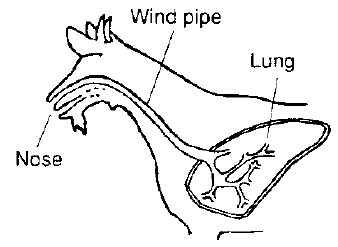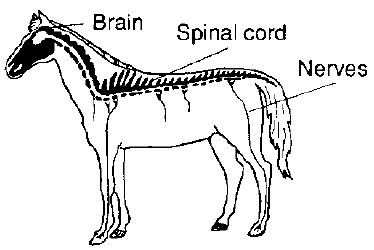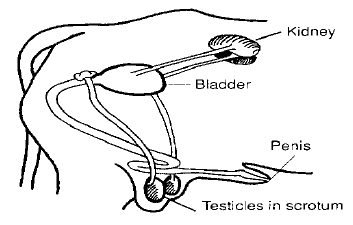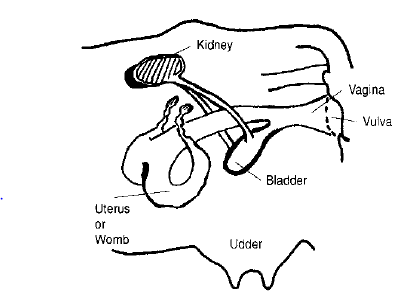Organs and systems of an animal body
Organs and systems of an animal body
The organs of the body
An organ is a complex structure with a special job or a number of jobs to do. For example:
- The eye is the organ of sight.
- The kidneys are organs which get rid of water and poisonous materials from the body as urine.
- The liver has many jobs and is involved in more than one system.
Various organs are grouped together to form a body system which carries out a special job.
The musculo-skeletal system
- This system consists of the bones and the muscles (meat). The bones form the skeleton which is the framework within the body. It carries weight and supports the body.
- Bones are connected together so they can move. The places where this happens are called joints.
- The bones are held together at the joints by elastic strands called ligaments.
- Between the bones is a softer material called cartilage (gristle) which cushions the bones at the joints when the body moves. Bones are very hard and contain minerals.
- Each bone has a name such as the scapula (shoulder blade) and skull (head). There are about 200 bones in the body.
- Muscles are joined at both ends to the bones. The muscles are the meat of the body and when they contract (shorten) or relax (lengthen) they make the bones move.
The digestive system
- The digestive system consists of the teeth, mouth, gullet (esophagus), stomach, liver, intestine, pancreas and rectum.
- Digestion begins in the mouth where feed is broken down into small pieces by the teeth and mixed with saliva before being swallowed. In the stomach feed is mixed with the juices to form a soft paste.
- This then passes into the intestine where bile from the liver and juices from the pancreas are added.
- The action of these juices is to break down the feed and allow the nourishment it contains to be absorbed by the blood in the walls of the intestine.
- Waste matter collects in the rectum and passes out of the body through the anus (or cloaca in birds).
The circulatory system and blood
- The organs of the circulatory system are the heart and the blood vessels (tubes).
- The heart is found in the chest cavity. It is a muscular pump which sends blood around the body.
- The blood vessels which carry blood away from the heart are called arteries. Blood returns to the heart in veins.
- Joining the arteries and veins is a fine network of small tubes called capillaries. The capillaries pass through every part of the body.
- When the heart beats its muscles contract and sends blood out through the arteries. When the heart relaxes blood flows into it from the veins.
- Every time the heart beats, it sends a pulse along the arteries. You can feel it at certain points on the body. By feeling the pulse we can count the rate at which the heart beats.
The respiratory system
- Respiration (breathing) consists of inspiration (breathing in) and expiration (breathing out).
- There are two lungs which are found in the chest protected by the bony cage of the ribs.
- The windpipe carries air from the nostrils to the lungs which are spongy because of air spaces in them.
- As the animal breathes, air moves in and out of the lungs.
- Inside the lungs oxygen needed by the body passes into the blood in the walls of the lungs and water and carbon dioxide pass out of the blood into the air which is then breathed out.

The urinary system
- The main organs are the two kidneys, which lie against the backbone, and the bladder.
- Waste materials and water are taken out of the blood in the kidneys. This forms urine. Urine collects in the bladder then passes out of the body.
- The bones of the skull and backbone protect the soft brain and spinal cord.
- Fibres called nerves pass from the brain and spinal cord to all parts of the
- Messages pass from the various parts of the body along the nerves to the brain. The brain sends a message back telling the different parts of the body what to do.
Nervous system
The brain controls the body. The brain also controls the senses; the sense organs are:
- The eyes for sight
- The ears for hearing
- The nose for smell
- The tongue for taste
- The skin for touch

Reproductive system (Breeding)
- The male reproductive organs, the testicles, lie in the scrotum behind the penis.
- The testicles produce sperm which are contained in the fluid semen.
- A tube passes from each testicle and joins to form a tube which runs down the centre of the penis.
- In the bird, the testicles are inside the body.

- The female reproductive organ consists of two ovaries, one in each side of the lower abdomen. The ovaries produce eggs which pass into the uterus (or womb).
- Below the uterus is the vagina which opens to the outside surrounded by the vulva. After birth the young are fed on milk produced by the udder.

- During mating (mounting) sperm passes from the male into the uterus and joins with the eggs there.
- When the sperm joins the egg, it forms the embryo which develops into the young animal inside the uterus.
- Reproduction is controlled by hormones (chemical messengers) which are carried in the blood to the different organs. These hormones control:
- Puberty of the animal
- Production of eggs
- Birth
- Production of semen
- Development of the embryo
- Milk production
Lympho-reticular system
- Lymph is a colorless fluid which passes out of the blood into a network of fine tubes called the lymphatic system.
- It passes through the lymph nodes, where germs are filtered out and killed, before it is returned to the veins.
- The lymph nodes and spleen also produce special blood cells which protect the body against disease.
- Sometimes when an animal is infected the lymph nodes become swollen and can be felt beneath the skin.
Source : Pashu sakhi Handbook
Last Modified : 7/3/2023
© C–DAC.All content appearing on the vikaspedia portal is through collaborative effort of vikaspedia and its partners.We encourage you to use and share the content in a respectful and fair manner. Please leave all source links intact and adhere to applicable copyright and intellectual property guidelines and laws.
RELATED ITEMS
Organs and systems of an animal body
This topic provides information about the various ...
RELATED LANGUAGES
